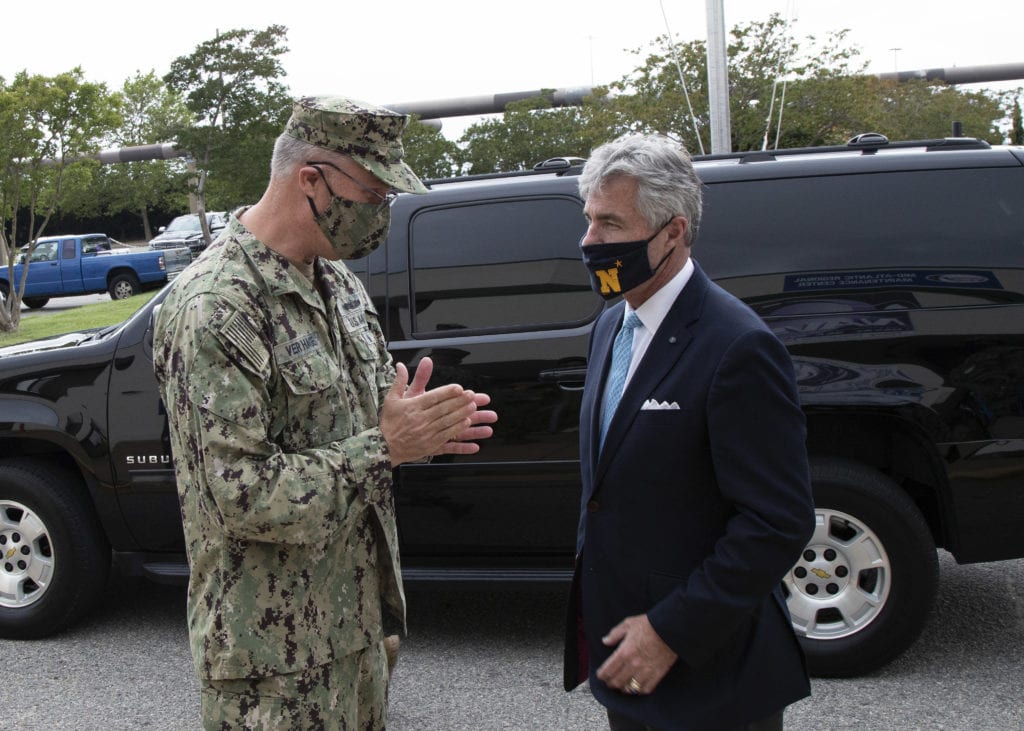
ARLINGTON, Va. — Three months after leaving office, the former secretary of the Navy is continuing to advocate for the re-establishment of a U.S 1st Fleet in the Southwestern Pacific and Indian Ocean and recommends the new fleet be expeditionary and sea-based.
Kenneth J. Braithwaite, the 77th secretary of the Navy and a retired admiral in the Navy Reserve, discussed the concept with Brent Sadler of the Heritage Foundation in an April 14 webinar, hoping the idea “will continue to extraction.”
While Navy Secretary, Braithwaite said he concluded that the expanse of the Western Pacific and Indian Oceans was too great for a single numbered fleet, the Japan-based U.S. 7th Fleet.
“One numbered fleet can’t double down on all of the emerging challenges in that part of the world,” he said, noting a “real void” in the South China Sea and the Indian Ocean.
He took note of the increased tensions with China in the South China Sea and the increased U.S. cooperation with India as demanding a more focused attention.
“We needed more emphasis in places where we are being challenged the most,” Braithwaite said. “I thought about the structure of the Navy and what had worked historically for the Navy may not work in the future.”
The actual intersections of the areas of responsibility (AORs) of the U.S. 3rd and 7th Fleets and the proposed U.S. 1st Fleet would be determined in the process, but Braithwaite said that “in the past most of our numbered fleets were at sea [and] operated aboard a flagship. I think that’s a concept we need to embrace again, especially as we enter this new period of great power competition. I think it need to be expeditionary and I think it needs to be sea-based.”
Braithwaite pointed out that his announcement of the concept of the 1st Fleet came on the eve of a trip to the Western Pacific.
“The idea seems to be one that many others, if they hadn’t been thinking specifically about the structure and the resurrection of the 1st Fleet, it was one that did meet with positive perspective once I had the opportunity to have those conversations with the [defense ministers] of those nations that would be impacted by it. That would include India, Singapore and Japan. All embraced the idea.”
Braithwaite said the 1st Fleet could be equipped with guided-missile destroyers, guided-missile frigates, littoral combat ships and expeditionary fast transports, operating as a squadron based in Singapore. He also said Coast Guard cutters could add capability to the proposed fleet.
“We do need a bigger Navy,” he said. “Ninety percent of trade moves across the sea lanes of the world, and as such, we need to make sure, as the predominant naval force, that they remain free.”
The status of the 1st Fleet concept within the new presidential is not yet known. President Joseph Biden has yet to nominate a new secretary of the Navy.
“One thing the Navy doesn’t do well is embrace change,” he said. I had to build up support from within, get people to think again about what might be possible. … It is a concept that has found some support.”
“I hope that my successor embraces [the 1st Fleet concept] as well once he is announced and confirmed,” he said.
- SECNAV Advocates Increased Legal Immigration to Increase Shipbuilder Workforce - April 23, 2024
- Insitu Going Strong at 30, Focusing on Maritime Operations - April 8, 2024
- Navy Awards Boeing Additional Funds for MQ-25 Drones for Testing - April 3, 2024






